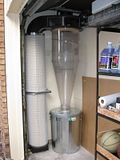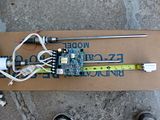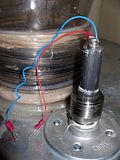Hello everyone,
I have been reading these postings for a couple of weeks and have finally taken the plunge. I should receive my new CV1800 this week. (Please forgive any forum faux pas made. I don’t usually join forums but this one looks too beneficial not to be part of.) My first thought reading some of the posts is that some of you have the patience of a saint or are exponentially busier than I am to wait months and in some cases years before putting your collector together. I have some shop layout changes I need to make to facilitate the install but I hope to be up and running soon.
With that I, like every other newbie, want to avoid making any costly mistakes. From my readings I understand the system is powerful enough to recover from any minor issues in design (run length, flex tube and turns) as long as I pay attention to air sealing and other critical steps. Got it - check.
Noise stands out as the next forum hot-button. Only having a Delta 1hp single stage, I picture myself turning this monster on and driving the local wildlife from the area, myself included. There are many ways to deaden sound discussed on the forums but is there one or two methods that although not be as “creative” as others prove to do the job reliably for reasonable cost? I am planning on building an enclosure for the unit with a padded baffle to vent air back into the room. I wanted to create a short list of “must haves” for a good install. Here is the list I am asking for feedback and comments on. Please add any I overlooked.
I read up on many of the discussions about dedicated motor circuits and necessary wiring/breaker sizing and feel comfortable with that. What about the nice to haves like remotes and full-bin sensors?
Remotes:
Thanks for your feedback and I look forward to learning from all of you.
I have been reading these postings for a couple of weeks and have finally taken the plunge. I should receive my new CV1800 this week. (Please forgive any forum faux pas made. I don’t usually join forums but this one looks too beneficial not to be part of.) My first thought reading some of the posts is that some of you have the patience of a saint or are exponentially busier than I am to wait months and in some cases years before putting your collector together. I have some shop layout changes I need to make to facilitate the install but I hope to be up and running soon.
With that I, like every other newbie, want to avoid making any costly mistakes. From my readings I understand the system is powerful enough to recover from any minor issues in design (run length, flex tube and turns) as long as I pay attention to air sealing and other critical steps. Got it - check.
Noise stands out as the next forum hot-button. Only having a Delta 1hp single stage, I picture myself turning this monster on and driving the local wildlife from the area, myself included. There are many ways to deaden sound discussed on the forums but is there one or two methods that although not be as “creative” as others prove to do the job reliably for reasonable cost? I am planning on building an enclosure for the unit with a padded baffle to vent air back into the room. I wanted to create a short list of “must haves” for a good install. Here is the list I am asking for feedback and comments on. Please add any I overlooked.
- Rock wool seems to be the preferred material to deaden sound, is that true?
- Separating the filters from the blower housing by insulated piping? Necessary if I am building an enclosure?
- Enclosing the actual impeller housing in sound deadening material, being sure to leave the motor open for cooling. Beneficial?
- Way to cool motor in fully enclosed “dust closet”. Necessary? (9'4" ceilings)
- Enclosure design – Any gotchas I need to know about?
- Vibration isolation – necessary if detached garage? (Tennis ball idea wins for creativity, willing to do the same if it worked well)
I read up on many of the discussions about dedicated motor circuits and necessary wiring/breaker sizing and feel comfortable with that. What about the nice to haves like remotes and full-bin sensors?
Remotes:
- In line master switch that kills the entire system so you do not have phantom starts, possibly wired to room lights for ease of use.
- X-10 – some report issues of reliability if tube lighting is in the room.
- Saw a link to a $40 unit that had good remarks. Need to find again. J
- Do all look at flex housing to determine full (LED and sensor or garage door beam)?
- Seems it would create a mess when opening bin?
Thanks for your feedback and I look forward to learning from all of you.




